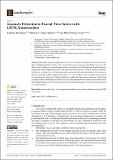Anomaly Detection in Fractal Time Series with LSTM Autoencoders
Author(s)
Kirichenko, Lyudmyla; Koval, Yulia; Yakovlev, Sergiy; Chumachenko, Dmytro
Downloadmathematics-12-03079.pdf (3.348Mb)
Publisher with Creative Commons License
Publisher with Creative Commons License
Creative Commons Attribution
Terms of use
Metadata
Show full item recordAbstract
This study explores the application of neural networks for anomaly detection in time series data exhibiting fractal properties, with a particular focus on changes in the Hurst exponent. The objective is to investigate whether changes in fractal properties can be identified by transitioning from the analysis of the original time series to the analysis of the sequence of Hurst exponent estimates. To this end, we employ an LSTM autoencoder neural network, demonstrating its effectiveness in detecting anomalies within synthetic fractal time series and real EEG signals by identifying deviations in the sequence of estimates. Whittle’s method was utilized for the precise estimation of the Hurst exponent, thereby enhancing the model’s ability to differentiate between normal and anomalous data. The findings underscore the potential of machine learning techniques for robust anomaly detection in complex datasets.
Date issued
2024-10-01Department
Massachusetts Institute of Technology. Computer Science and Artificial Intelligence LaboratoryJournal
mathematics
Publisher
Multidisciplinary Digital Publishing Institute
Citation
Kirichenko, L.; Koval, Y.; Yakovlev, S.; Chumachenko, D. Anomaly Detection in Fractal Time Series with LSTM Autoencoders. Mathematics 2024, 12, 3079.
Version: Final published version